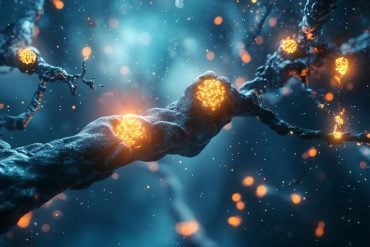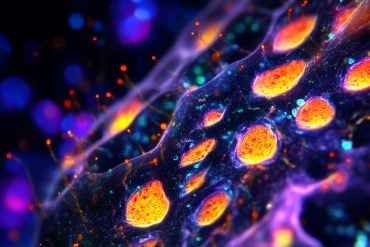Summary: Genetic changes associated with Parkinson’s disease have been found in liver, fat, immune and developmental cells, a new study reports.
Source: Van Andel Research Institute.
Clues that point toward new risk mechanisms for developing Parkinson’s disease are hiding in some unusual spots, according to a study published today in Scientific Reports.
Tiny changes in DNA that have been linked to Parkinson’s, the second most common neurodegenerative disorder after Alzheimer’s, were found not only in brain cells, where they were expected, but also in liver, fat, immune and developmental cells. These findings may one day contribute to the development of preventative interventions before the disease’s effects become pronounced.
“When we looked at the data, we were quite surprised to see the variation in tissue types,” said Gerry Coetzee, Ph.D., a professor at Van Andel Research Institute (VARI) and the study’s corresponding author. “Ultimately, if we can more precisely define risk factors for Parkinson’s, we can develop ways to mitigate them early on. We still have a long way to go but these findings are some of the first steps down that path.”
A cumulative effect
Although these changes, called single-nucleotide polymorphisms (SNPs), are very small, an accumulation of enough SNPs can significantly heighten a person’s risk for developing Parkinson’s. It can be likened to dropping sand onto a scale–a single grain will have little effect, but if enough grains are added, the balance will tip.
The human genome contains about 80 million SNPs, many of them located in regions of the DNA that were once thought to be junk. Scientists now know that these areas, located outside of genes on the DNA, play critical roles in regulating gene expression and are a useful tool for matching a particular gene with its function or role in disease.
As such, investigating SNPs linked to Parkinson’s offers a unique opportunity to answer one of the major questions in Parkinson’s research–what causes or contributes to the disease? While scientists know that five to 10 percent of Parkinson’s cases are passed down genetically through families, they’re still determining what’s behind the majority of cases. The prevailing theory is a mix of genetic and environmental factors create a perfect storm, leading to the hallmark clumping of abnormal proteins that spread through the brain, killing cells that produce a chemical called dopamine that is vital for voluntary movement.
Different tissues, common link
Using information from the federally funded Roadmap Epigenomics Mapping Consortium as a guide, Coetzee, the team at VARI and collaborators at Cedars-Sinai in Los Angeles analyzed 21 of these risk areas, called loci, in 77 cell types. Of these, the team found 12 loci across several tissue types that were particularly enriched–or full of SNPS–indicating an increase in risk.
Intriguingly, only one locus was identified in the substantia nigra, the part of the brain where dopamine-producing neurons die. Other loci were found in liver, fat, immune and developmental cells. It is the first time this type of genome-wide analysis has been used to investigate Parkinson’s disease.

Although much more work must be done to unravel exactly how these loci affect risk, there are interesting parallels between the team’s findings and recent work done by others investigating Parkinson’s. For example, three of the risk loci were found in immune cells, a promising finding as evidence suggests that Parkinson’s may be linked to inflammation, the immune system’s reaction to help fight off potential threats.
“Only a small percentage of Parkinson’s cases are familial and have a clear and well-defined genetic inheritance. The remaining cases develop the disease seemingly at random,” said Patrik Brundin, M.D., Ph.D., director of VARI’s Center for Neurodegenerative Science and one of the study’s authors. “The emerging view is that Parkinson’s is more of a syndrome–a defined set of clinical symptoms and some shared features of brain pathology–with a diverse set of underlying causes. One surprising finding in our study is that only one gene locus was clearly linked to the brain while others were associated with tissues throughout the body. This supports the emerging theory that Parkinson’s is a disorder that can be caused by disruptions in cellular processes in many locations, not just one. Furthermore, for the disease to develop in one person there has to be an unfortunate combination of a genetic predisposition and, as yet undefined, environmental insults.”
Funding: This work was supported by funding from Van Andel Research Institute and Cedars-Sinai.
Source: Beth Hinshaw Hall – Van Andel Research Institute
Image Source: This NeuroscienceNews.com image is in the public domain.
Original Research: Full open access research for “Enrichment of risk SNPs in regulatory regions implicate diverse tissues in Parkinson’s disease etiology” by Simon G. Coetzee, Steven Pierce, Patrik Brundin, Lena Brundin, Dennis J. Hazelett and Gerhard A. Coetzee in Nature. Published online July 27 2016 doi:10.1038/srep30509
[cbtabs][cbtab title=”MLA”]Van Andel Research Institute. “Indicators of Parkinson’s Found in Unexpected Places.” NeuroscienceNews. NeuroscienceNews, 27 July 2016.
<https://neurosciencenews.com/parkinsons-immune-cells-fat-4748/>.[/cbtab][cbtab title=”APA”]Van Andel Research Institute. (2016, July 27). Indicators of Parkinson’s Found in Unexpected Places. NeuroscienceNews. Retrieved July 27, 2016 from https://neurosciencenews.com/parkinsons-immune-cells-fat-4748/[/cbtab][cbtab title=”Chicago”]Van Andel Research Institute. “Indicators of Parkinson’s Found in Unexpected Places.” https://neurosciencenews.com/parkinsons-immune-cells-fat-4748/ (accessed July 27, 2016).[/cbtab][/cbtabs]
Abstract
Enrichment of risk SNPs in regulatory regions implicate diverse tissues in Parkinson’s disease etiology
Recent genome-wide association studies (GWAS) of Parkinson’s disease (PD) revealed at least 26 risk loci, with associated single nucleotide polymorphisms (SNPs) located in non-coding DNA having unknown functions in risk. In order to explore in which cell types these SNPs (and their correlated surrogates at r2 ≥ 0.8) could alter cellular function, we assessed their location overlap with histone modification regions that indicate transcription regulation in 77 diverse cell types. We found statistically significant enrichment of risk SNPs at 12 loci in active enhancers or promoters. We investigated 4 risk loci in depth that were most significantly enriched (−logeP > 14) and contained 8 putative enhancers in the different cell types. These enriched loci, along with eQTL associations, were unexpectedly present in non-neuronal cell types. These included lymphocytes, mesendoderm, liver- and fat-cells, indicating that cell types outside the brain are involved in the genetic predisposition to PD. Annotating regulatory risk regions within specific cell types may unravel new putative risk mechanisms and molecular pathways that contribute to PD development.
“Enrichment of risk SNPs in regulatory regions implicate diverse tissues in Parkinson’s disease etiology” by Simon G. Coetzee, Steven Pierce, Patrik Brundin, Lena Brundin, Dennis J. Hazelett and Gerhard A. Coetzee in Nature. Published online July 27 2016 doi:10.1038/srep30509






